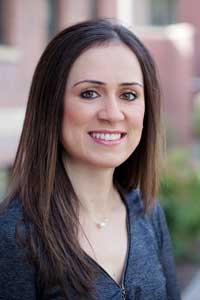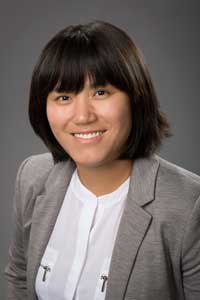The College of Engineering has been growing rapidly, hiring more than 30 new faculty over the past three years. Two recently hired assistant professors at the University of Nevada, Reno sat down with us to discuss their research, their path toward becoming engineers and what they enjoy about working in the College of Engineering.

While we teach, we learn
Before obtaining her Ph.D. in biomedical engineering from the University of Nevada, Reno in 2016, and eventually joining the Department of Electrical and Biomedical Engineering in 2017, Josette El Zaklit received her B.S. in biomedical engineering from the Ecole Supérieure d'Ingénieurs de Beyrouth, Lebanon, and her M.S. in medical imaging and biotechnology from the Ecole Centrale Paris, France.
While both El Zaklit and Cao cited a fondness for physics and math as a starting point for their engineering careers, El Zaklit's early interest in life science also influenced her higher educational choices.
"I became very interested in biological sciences in high school, and being able to combine engineering principles with biological sciences is what started my interest in biomedical engineering," El Zaklit said. "It was a very novel discipline in Lebanon. We had only ten students to graduate with a bachelor's degree in biomedical engineering, and because no higher degrees were offered in Lebanon, I had to travel to France to get my master's and to the U.S. for my Ph.D."
El Zaklit's research set her up as one of the prominent minds in her field. The research focused on a combination of computational and experimental approaches to better understand high intensity, nanosecond pulsed electric fields (nsPEFs) on bovine chromaffin cells, which are neural-type secretory cells. Her research was part of a larger project investigating the potential for nsPEFs to be used as a safe and non-invasive approach for neuromodulation. She presented her research at the International Annual Meeting of the Bioelectromagnetics Society in Asilomar, California in 2015 where she was awarded the second place platform for presenting students among 15 national and international presentations.
"What I love about my area of research is that it involves both the engineering aspect as well as the biological aspect," El Zaklit said. "Currently, I am also expanding my research interests into another type of excitable cell system - the cardiac muscle - to investigate the potential for a new type of electric stimulus, bipolar nsPEFs, to be used as a safe and noninvasive approach to altering cardiac cell excitability and consequently excitation-contraction coupling (EC coupling)."
As well as expanding on her Ph.D. research, El Zaklit has also found that the opportunity she has to teach subjects within electrical and biomedical engineering has helped her better understand the subject, as well as driving her to improve her means of communicating her lessons.
"Teaching is something I have learned throughout the years, and something I have loved since I was a young girl," El Zaklit said. "I have been blessed to have had several great teachers, starting with my mother, who taught me to love learning itself. I believe it is true that ‘while we teach, we learn' and I when I prepare material for my courses, I learn how to express my thoughts in a logical and reasonable way, and I learn from the students themselves when they ask questions."

Representation in the STEM field
Lei Cao received her B.S. from the Department of Precision Instruments, Tsinghua University, and her Ph.D. from the School of Mechanical Engineering, Purdue University. She joined the University of Nevada, Reno as an assistant professor of mechanical engineering in 2016 where she continued to develop her Ph.D research.
While at Purdue University, Cao worked on creating computational models of microstructures within metals, specifically nickel, and enhancing its mechanical properties to change the strength and tactility of the metal without changing other mechanical properties in the process. As well as adding to our understanding of the actions of atoms at the nanometer level, Cao's Ph.D. research, combined with her recent work in solid mechanics, has lead to ballistics-related studies including research regarding bulletproof materials.
"At the moment, I'm working with professor Qi An in the chemicals and materials engineering department where we're focusing some of the work I did with metals on ceramics and understanding the microstructure of boron carbide, specifically," Cao said. "It's the third hardest material in the world, so it has a very high strength, but it's very brittle because it's a ceramic. So were looking into modeling ways to increase its tactility without sacrificing its strength."
Cao has found, since arriving at the University of Nevada, Reno, her chance to collaborate with those in and outside of the mechanical engineering department has allowed for a growth in how she works and well as what material she works with.
"The kinds of collaborations I'm able to do here at the University have given me the opportunity to work in areas I haven't been a part of before," Cao said. "I don't have to label myself as someone who just works with metals. I can extend my work into other materials that are harder or softer. The collaborations across all fields of engineering give everyone in the different departments, myself included, the chance to validate experiments with each other, making their results more accurate and stronger within their own research."
Outside of collaborative work and increasing the focus of her research, Cao hopes her role as a woman in engineering can highlight how important representation is, and the implications a lack of representation can have in the academic world.
"One common thing I get asked is how I feel about choosing the field of engineering as a woman or if I feel a sort of responsibility, and I do feel a responsibility," Cao said. "I think it's very important to have more women engineers in the STEM field because we don't realize how important it is to have role models for students. If you're checking out the engineering department and you don't see any women researchers, then undergraduates won't look at this field as a possibility for a sustainable future career choice. Students who visit the University will avoid this department even if it's something they want to do, because they won't see themselves in the work that's being done. I feel that responsibility to show the younger female audiences that you can do this, and I feel that responsibility to promote this as a career choice for any young women students who want to pursue the different areas of engineering."












